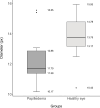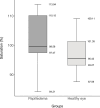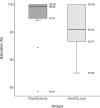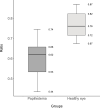Retinal Vessel Oxygen Saturation in Patients with Unilateral Edema of the Optic Nerve Head: A Pilot Study
- PMID: 40657237
- PMCID: PMC12255252
- DOI: 10.2147/EB.S524274
Retinal Vessel Oxygen Saturation in Patients with Unilateral Edema of the Optic Nerve Head: A Pilot Study
Abstract
Purpose: Evaluate whether optic disc edema results in changes in retinal microcirculation.
Patients and methods: The study group consisted of 11 patients with unilateral optic disc edema (papilledema). The control group consisted of the healthy eyes of the same 11 patients. Patients underwent non-invasive photo-spectrometric retinal oximetry using Oxymap T1 retinal oximeter (Oxymap, Reykjavik, Iceland). In the eyes of these 11 patients, we examined the diameter of the retinal arteries and veins, arterial and venous blood oxygen saturation, and the difference in oxygen saturation between arterioles and venules (A-V difference).
Results: In the papilledema group, the decrease in the retinal arterial diameter was statistically significant (p=0.001). The median diameter of the retinal artery was 11.70 px (IQR 1.47) or after conversion 109.00 µm (IQR 14.00) in the papilledema group and 13.75 px (IQR 1.61) or 128.00 µm (IQR 15.00) in the control group. The increase in the diameter of the retinal veins in the papilledema group was statistically significant (p=0.012), where the median diameter in the papilledema group was 20.88 px (IQR 3.72) or 194.00 µm (IQR 35.00), and in the control group was 18.18 px (IQR 3.60) or 169 µm (IQR 33.00). There was a statistically significant decrease (p<0.001) in the venous saturation in the papilledema group with a median value of 53.16% (IQR 17.38) and 60.02% (IQR 11.98) in the control group. The median of the A-V difference was 51.92 (IQR 15.96) in the papilledema group, resp. 38.49 (IQR 9.75) in the control group and a significant increase in the papilledema group (p<0.001) was reported.
Conclusion: Automatic retinal oximetry demonstrated changes in the retinal microcirculation in patients with optic disc edema.
Keywords: microcirculation; oximetry; papilledema; retina.
© 2025 Březík et al.
Conflict of interest statement
The authors report no conflicts of interest in this work.
Figures











Similar articles
-
Is the presence of peripapillary hyperreflective ovoid mass-like structures (PHOMS) in children related to the optic disc area, scleral canal diameter and refractive status?Eye (Lond). 2025 Feb;39(2):296-299. doi: 10.1038/s41433-024-03420-7. Epub 2024 Oct 22. Eye (Lond). 2025. PMID: 39438745
-
Prophylactic non-steroidal anti-inflammatory drugs for the prevention of macular oedema after cataract surgery.Cochrane Database Syst Rev. 2016 Nov 1;11(11):CD006683. doi: 10.1002/14651858.CD006683.pub3. Cochrane Database Syst Rev. 2016. PMID: 27801522 Free PMC article.
-
Face-down positioning or posturing after macular hole surgery.Cochrane Database Syst Rev. 2023 Nov 21;11(11):CD008228. doi: 10.1002/14651858.CD008228.pub3. Cochrane Database Syst Rev. 2023. PMID: 37987517 Free PMC article.
-
Inappropriate Use of the Term "Papilledema" in the Medical Literature: A Systematic Review of Case Reports across Specialties.Ophthalmology. 2023 Feb;130(2):129-136. doi: 10.1016/j.ophtha.2022.09.017. Epub 2022 Oct 3. Ophthalmology. 2023. PMID: 36195254
-
The Value of Optical Coherence Tomography in Patients with Pituitary Adenoma and Its Association with Clinical Features: A Pilot Study.J Clin Med. 2025 Jun 17;14(12):4318. doi: 10.3390/jcm14124318. J Clin Med. 2025. PMID: 40566061 Free PMC article.
References
-
- Diblík P. Neurooftalmologie. In: Heissigerová J, editor. Oftalmologie. Prague: Maxdorf sro. 2021:303–306.
-
- Rambousek J, Preiningerová Lízrová J, Česká M B, Hložánek M. Otoky terčů zrakového nervu - společné téma oftalmologů a neurologů. Neurol praxi. 2023;24(2):88–93. doi: 10.36290/neu.2022.074 - DOI
LinkOut - more resources
Full Text Sources

